Neck Sharpies: Air Force’s 50-Slant Defense

I thought Air Force had a very good defense. They weren’t big or super fast, but they were smart and sound—if a defense as a whole could get a nickname I’d call them Ol’ Eleven Kovacses.
Their gameplan was also brilliant. They knew Michigan wanted to run inside the tackles, get Speight some confidence, and get athletes out to the edge, so Air Force came in with a plan to jam up running lanes and make Michigan try to guess where the big hole would be. This is AF’s look on Michigan’s first running play:
They’re in base 3-4 personnel, with both ends lined up in 5-techniques (over the tackles’ shoulders), both OLBs in 7-techniques (over the TE or hypothetical TE’s shoulders) and one safety down at linebacker depth to react to Michigan putting a lineman (Ruiz) at tight end.
Now this is not Belicheck’s mother’s 3-4. That nose tackle was 5’11/260. He certainly wasn’t going to be two-gapping. Rather out of this setup Air Force’s plan was to have the nose attack almost like Brown’s 3-3-5 linebackers, appearing in any A or B gap on any given play and making life hard on Michigan’s inexperienced interior OL to figure out what to do with him.
If that all sounds familiar, it’s because you’re old, and it is:
That’s right: that sonovabitch Calhoun walked into Michigan Stadium and tried to run Bo Schembechler’s defense on us.
[After the JUMP: The 50 slant, and picking holes in it]
------------------------------
THE 50 SLANT DEFENSE
beef-to-speed spectrum in play. it’s “50” because 5 men on the line, center in a 0-tech
This defense is similar to Don Brown’s 3-3-5 in that it’s a gap defense like a 4-3, where each player has a gap they can focus on rather than reading and reacting. Also like the 3-3-5 it expects to be using lighter players and makes up for that by surprising you with which gap they’ll be in. They both use a smallish nose for that purpose. The 50 slant is an extremist in this regard—rather than using a linebacker as a surprise fourth DE, they’ll have their defensive linemen constantly slanting into gaps they didn’t line up over.
The key is that nose tackle. You know the story of Donnie Warner? If not, imagine Rudy was about an actually impressive person rather than a con artist who played one garbage down. Donnie was about the size of Mike Hart and played nose guard for the stoutest defense in the country. Interior OL in the mid-’70s were about 250 so if you’re trying to imagine Donnie today imagine Devin Bush playing nose tackle. This was the basis of one of the great Michigan defenses of all time.
Donnie would line up in the middle of that defense and read subtle cues from the offense to guess where and how he should attack each play, and communicating that to his teammates. He was a master at reacting—shoving the holes next to him closed and refusing to give up ground, often taking two linemen out each play. If you tried to double him and attack inside gaps, well, the other linemen were slanting into those all the time. Meanwhile the strong safety, which Bo called the “Wolf”, would be hanging out where Don Brown puts his viper, and cleaning up in much the same way. It was really really hard to run on Michigan—you basically had to guess where they weren’t slanting, and hope you didn’t give away your intentions when Donnie started reading you.
A QUICK SLANTING REFRESHER
Slanting in the gap defense sense of the word means to twist gaps between your DL and LBs. Let’s envision a super-basic 3-4 front:
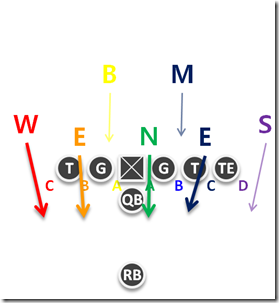 | 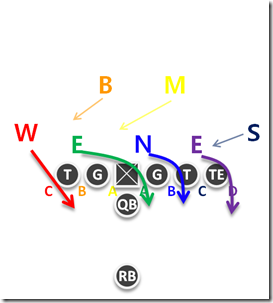 |
| normal 3-4 | hard frontside slant |
The gap assignments are what you’re lined up over. But everybody changes their fronts up a ton, because if you don’t you become easy to attack. One tried and true curveball to throw an offense is to have the DL all angle over a gap or more after the snap and the linebackers then “scrape” to fill the abandoned lanes. Same look before the snap, but after it the attackers are not where you expect them to be.
The point is you have to cover all of these gaps but you can only stuff so many of them with linemen (or blitzers, Don Brown adds), because you need some of your front to be in coverage.
You don’t have to slant every guy, in fact it’s more common to only do it with one or two pairs. Here’s a canonical slant from Indiana last year:
A lot of the cat and mouse games that offenses and defenses play are changing gap responsibilities, trying to put an immediate attacker—either a defensive lineman or a blitzer—into the offense’s preferred running lanes. The offense in turn tries to run where there are more linebackers.
Here’s a play from later in the game where the defense’s slant guessed correctly.
Michigan there is running inside zone. Air Force has a subtle frontside slant on. Again, I think they’re shifting the direction of this with motion:
Note how like with Don Brown’s defense the three defensive backs are rotating when McKeon motions from that three-back look to a 2TE front. Also note that Air Force has 8 1/2 men in the box. It’s hard to run off-tackle when there’s a defensive back plowing into the tackle at the handoff:
To keep Michigan from just going long on those run-focused safeties, Air Force played their corner off the receiver. Michigan had the option of easy yards with quick passes to the receivers, but taking easy yards wasn’t the gameplan, for one, and two Air Force expects that and their DBs were reacting very quickly to it.
No, the way to beat this stuff is Western Front style: find the hole they left you by moving too much material to where they think you’re going, and bust a hole through. It’s not pretty; in fact until you do beat them through the soft spot it’s going to be a long stalemate.
On this play, a quick backside attack off Ulizio and Onwenu was likely to find soft linebackers getting devoured like so many grapes. By the time Isaac realizes this and is cutting back to it, those linebackers have been able to rally, and the overhang cornerback is in position to run up into the gap. The Mike woops Onwenu, the DB comes up, and this is a minimal gain:
Inside zone is built to attack the gap that shows, but it also reads outside-in, and by the time you’re cutting back the defense has an opportunity to get reinforcements to the line. You can beat anything by simply kicking ass—the question here is how to put the players in position to do so. So let’s go back in time and see what happens when Michigan did choose the right gap.
THE PLAY
On this one (again, possibly a check due to the McDoom jet motion), the nose slanted into the frontside “B” gap, with linebackers now accounting for both A gaps and the backside B. They’re expecting Michigan to run to the side with Ruiz as a tight end and McDoom as a potential ballcarrier and Hill lined up like a shock panda, and they’re further convinced when Speight’s path to the ballcarrier is that direction.
Fools.
Michigan actually came out passing and play-action passing, perhaps to see if they could get a sense of how Air Force was going to set up against the run. After picking up a [pours one out] first down on Tarik Black’s great sideline catch, they ran their first run.
Sorry it’s hard to see all of those arrows. Michigan correctly guessed that Air Force’s response to overloading one side then running jet motion that way would be to roll the coverage and slant to the frontside. That puts a nose tackle immediately in the frontside B gap that a power run would love to attack, and in case of jet the free safety is coming down ready to make it a short “Doooom”.
With the backside DE twisting with the WLB that leaves three linebackers for the inside gaps to the backside that this play attacks. Twisting the WLB inside on this play is like showing up to a surprise party at the same time as the guest of honor. Surprise! Thwack.
Still the room here is created by the DL abandoning the backside, allowing Bredeson a free release into both linebackers. Bredeson pops the Backer (B)* at the 40 yard line…
…getting the unblocked MLB (M) stuck behind that so he can’t make a tackle attempt on Isaac. Isaac is now getting up to speed, which for him is plenty to squirt through the gap created by Hill’s block and Cole’s kickout.
And here’s the last piece: with the safeties playing up to cover run gaps, they’re not in position to keep this down. That’s a rotated cornerback playing midfield when Isaac burst through and is heading downfield at plaid speed. After two bad steps upfield the cornerback just baaaaarely gets enough of Isaac that his foot falls a centimeter out of bounds.
LESSONS
A tip of the cap to Air Force: Calhoun had a great gameplan for Michigan (and a highly apropos one) that was a good fit for their personnel. The whole point of their defense was to make Michigan’s running game an all-or-nothing prospect. Michigan had to guess each play where the soft spots would be, and if they chose wrong there were 9 potential box players ready to stuff for no gain. Michigan’s backs on occasion missed some of those breakthrough points that the coaching found them—I’m sure the UFR will highlight a few of them, though often those gaps were waaay backside cuts that you don’t normally expect to be there. The point is don’t be too hard on the running game for not blowing a Mountain West team off the line, and certainly don’t be hard on Michigan’s coaches. Air Force made it hard.
------------------------
* [Everyone has different terminology. I like to call the second middle linebacker in a 3-4 the “Backer” because it makes labeling easier. A lot of 3-4 defenses call him the “Will”, since he’s similar to a 4-3 WLB, then make up a cool prospectin’ name for their weakside LB. That is easier on players but more confusing in diagrams.]
September 20th, 2017 at 2:21 PM ^
Bo actually called them OLBs after awhile. The modernization you refer to occurred around 1977, at least in what Michigan's terminology became. Tom Seabron, who was a friend of my dad, was called an "Outside Linebacker" his whole Michigan career. He backed up Dominic Tedesco, who's called an OLB as a senior and a DE prior to that.
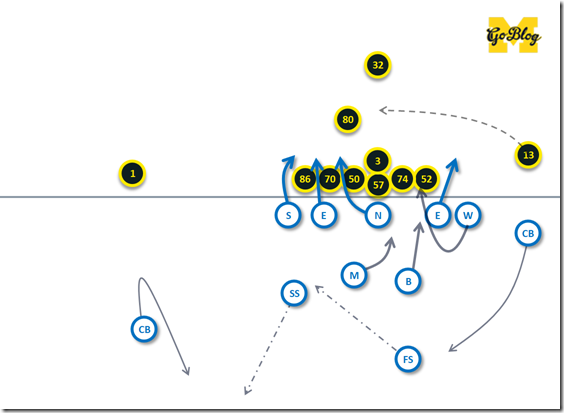


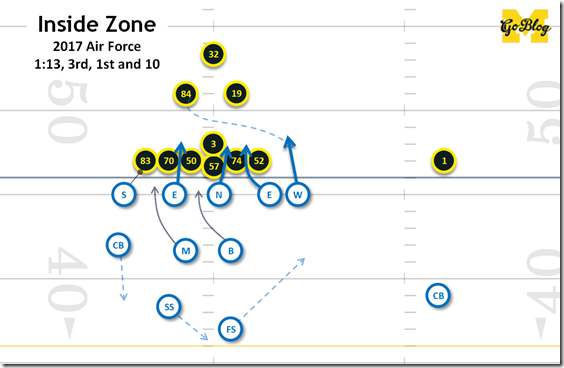
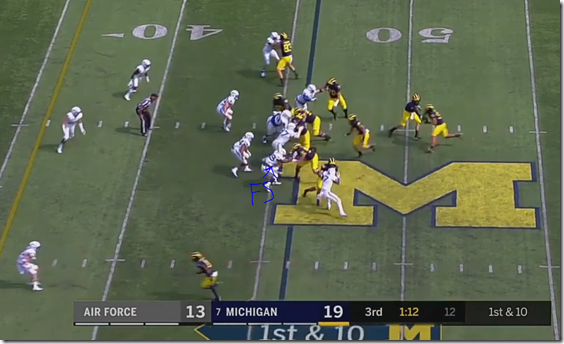
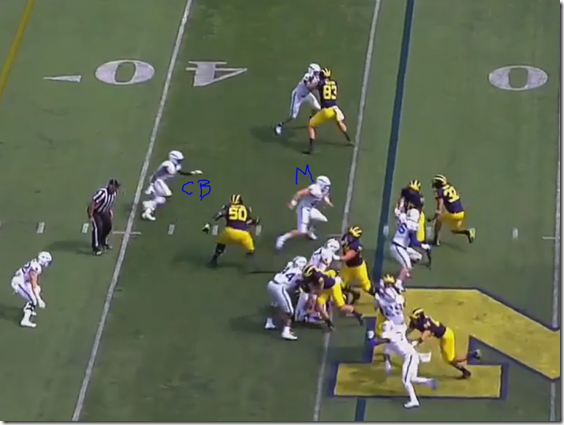

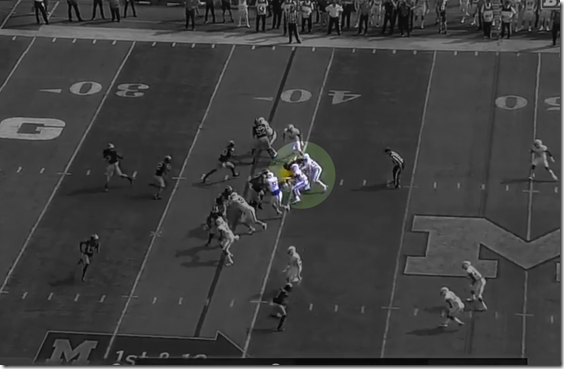
Comments